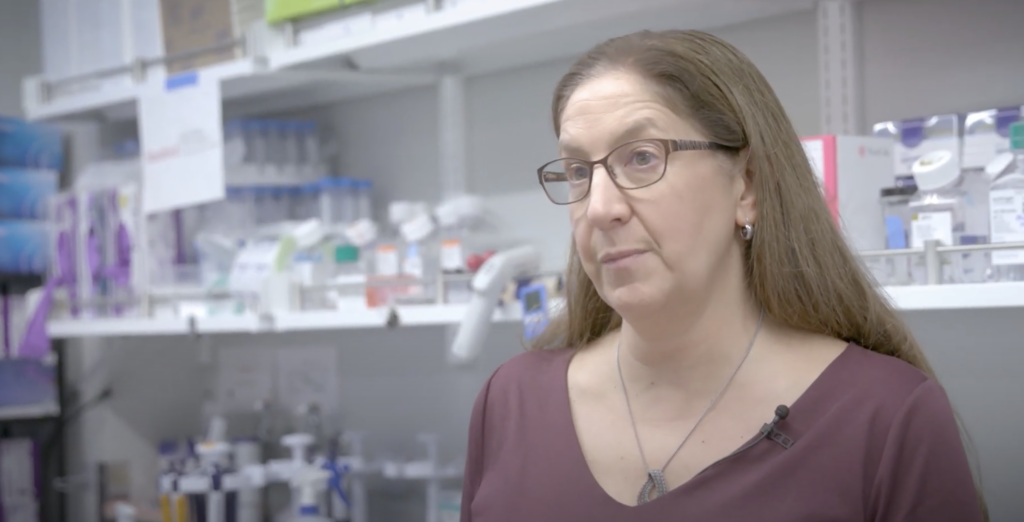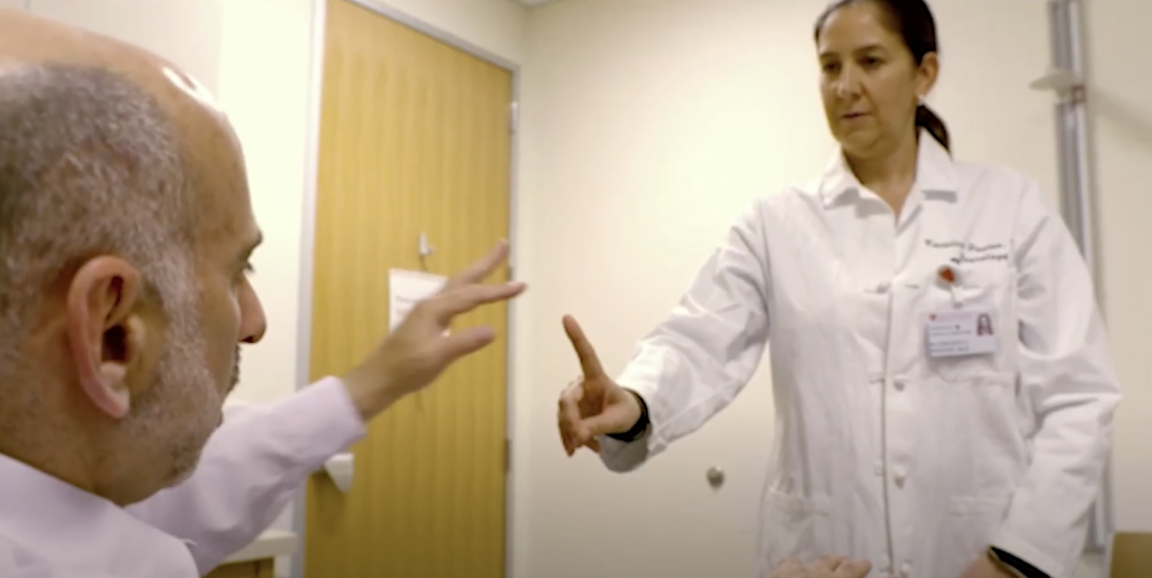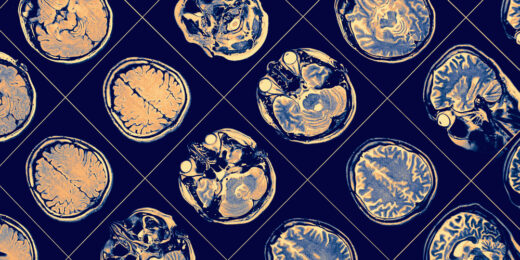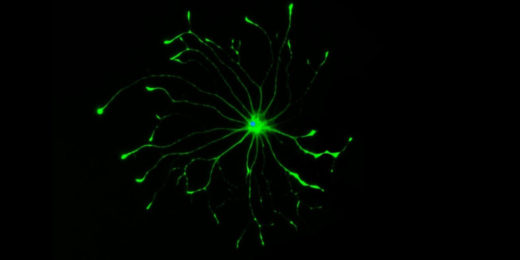Parkinson's disease is the second most common neurodegenerative disease, behind Alzheimer's disease, and affects nearly a million people in the United States.
The disease causes dopamine-producing brain cells to die and patients typically experience tremor, stiff muscles and slow movement as well as cognitive deficits. Medications to increase dopamine levels can help alleviate many of the motor symptoms -- but there is no cure.
Kathleen Poston, MD, the Edward F. and Irene Thiele Pimley Professor II in Neurology and the Neurological Sciences, has dedicated her career to helping patients with Parkinson's and to studying its root causes in the lab.

There were also a lot of unknowns, which piqued the interest of the research part of my brain.
Kathleen Poston
Her interest in Parkinson's developed during her medical training. "As a clinician, it was a rewarding field because, compared to other neurodegenerative diseases, there were many therapies we could offer patients," she said. "But there were also a lot of unknowns, which piqued the interest of the research part of my brain."
Recently, Poston's lab has been part of an international effort supported by the Michael J. Fox Foundation for Parkinson's Research to develop a diagnostic test that can detect the earliest biological signs of the disease.
They've shown that the new biomarker -- a clumping protein in the brain -- can predict who will go on to develop Parkinson's, giving patients and researchers more time to test experimental treatments.
We asked Poston about the latest advances in the field and how early diagnosis may finally lead to a cure. This interview has been edited for clarity and brevity.
How has our understanding of Parkinson's disease changed in recent years?
The biggest shift recently has to do with our understanding of how to diagnose the disease. With certain types of brain scanning and now with a biological marker, we can be more precise and accurate in our diagnosis earlier.
Traditionally we've only been able to diagnose people with Parkinson's disease based on the same standardized exam that's been done for 50, 60 years. We rate someone's motor symptoms -- slowness, stiffness, tremor. But it's hard to identify people early on in the disease. Until somebody really had those symptoms, it was hard to say for certain, "Yes, you have Parkinson's disease." Patients often say it took two years for them to be diagnosed, or they had to see four or five different doctors.
I think it's meaningful to people living with the disease just to get the right diagnosis as early as possible. People can manage once they know what they're dealing with. But when you're in that unknown time, it's very, very hard.
The newer biomarker we can test for now is alpha-synuclein. Does everyone who has this biomarker go on to develop Parkinson's?
Alpha-synuclein is a protein we all have in our brains, but for some reason it's in these clumping forms in people who have Parkinson's disease. We now know it's the primary protein that makes up Lewy bodies, the protein aggregates that form in the brain cells that die in people with Parkinson's disease.
It wasn't until after someone died that a pathologist could look at their brain under a microscope and make a definitive diagnosis. Blood tests and brain scans didn't seem to work.
Kathleen Poston
We've never been able to definitively identify, during a person's lifetime, whether they have these Lewy bodies in their brain, even if they have a clinical diagnosis of Parkinson's or a similar clinical disorder called dementia with Lewy bodies. It wasn't until after someone died that a pathologist could look at their brain under a microscope and make a definitive diagnosis. Blood tests and brain scans didn't seem to work.
We now have the first test that accurately identifies clumping alpha-synuclein. Researchers put seeds of alpha-synuclein in a sample of the patient's cerebral spinal fluid, then stress it by putting it through a series of heating, shaking and fragmenting to see if this nucleus clumps together. The test has extraordinary accuracy to the final pathology. It's about 99% accurate in people with a clinical diagnosis and also very accurate in people prior to a clinical diagnosis.
- Stanford Medicine-led study finds genetic factor fends off Alzheimer's and Parkinson's
- Alzheimer's and Parkinson's biomarkers show promise for early diagnosis
What we don't know -- and the reason this is all still in research -- is whether a person with a positive test will develop Parkinson's disease in a year, or five years, or 10 years. It's just a "yes" or "no" readout, which doesn't tell you anything about how bad the disease is or when it will develop. So there's a lot more work that needs to be done.
You're part of a group that recently published a proposal for a biological definition of Parkinson's based on alpha-synuclein. What does that mean and why is it important?
If we're trying to come up with a therapy that can prevent someone who has the underlying biology of Parkinson's disease from ever developing clinical symptoms, we need a biological definition that's 100% based on biomarkers -- such as clumping alpha-synuclein -- and not dependent on clinical symptoms.
Right now, this biological definition is proposed strictly in research settings so we can identify people with that biology who we would want to enroll in preventative clinical trials.
The earlier we can identify people who we feel confident have Parkinson's disease, the more we can think about slowing or stopping the disease progression. It gives us a window into the disease when there's not as much damage done, when it's easier to test potential therapies.
You have an exciting paper coming up later this year. Can you tell us what that will be about?
Here at Stanford we've been banking cerebral spinal fluid samples for a long time. In the new study, we showed that the alpha-synuclein test was able to predict a future diagnosis of Parkinson's in multiple people.
Also, it turns out, about 10% to 20% of people with Alzheimer's disease at death will also have this Lewy body pathology in their brain -- and now we can detect that earlier. That could change how we think about treating people with Alzheimer's as well.
That could change how we think about treating people with Alzheimer's as well.
Kathleen Poston
This is the big advantage of having the combination of banked samples, longitudinal clinical testing and individuals agreeing to autopsy and having that final diagnosis -- being able to put the whole story together. It's wonderful that all these participants volunteered to give all this information over the past 15 years and we were able to rapidly make use of it.
Looking forward, what are you most excited about?
There are two things that really excite me.
I'm working with other researchers to translate this alpha-synuclein test into a simple blood test or some other test that is readily accessible. Doing this test in the cerebral spinal fluid is quite restrictive and not every person is going to get a lumbar puncture at their annual wellness checkup.
We're doing plasma banking for all the people diagnosed with Parkinson's in our clinic. When one of my collaborators here develops something that takes it from cerebral spinal fluid into plasma, we can then quickly test it on 500 to 600 samples from our clinic.
What also excites me is figuring out how we can really accelerate therapeutic development to get to that preventive therapy. I'm working with researchers here at Stanford who are interested in therapies targeting these clumping proteins.
I hope that, in a couple of years, we're having this conversation and I'm telling you about the first FDA-approved disease-modifying therapy for Parkinson's disease. That would be wonderful.
Image courtesy Michael J. Fox Foundation for Parkinson's Research






